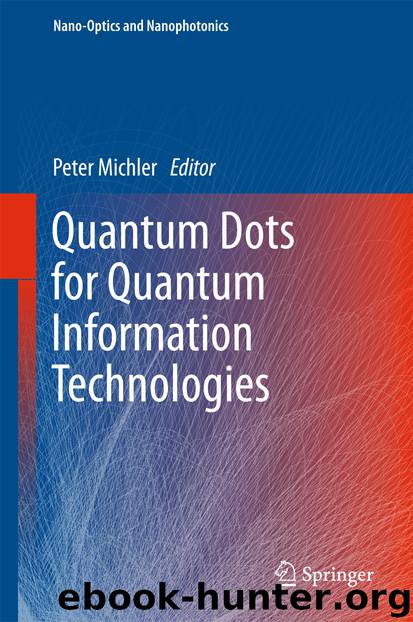Quantum Dots for Quantum Information Technologies by Peter Michler

Author:Peter Michler
Language: eng
Format: epub
Publisher: Springer International Publishing, Cham
(GHz)
(GHz)
(GHz)
(ns)
(ps)
X
0.85
0
692
X
0.91
0
673
X
0.96
431
Using the above noise correlations, the time-integrated normalized two-photon correlation can be calculated, which now depends on the specific dephasing parameters. The two-photon interference visibility V can then be expressed via . We are now able to explicitly formulate the dependence of the visibility on the pulse separation , the pure dephasing , and the diffusion constant :
(6.8)
where a balanced beam-splitter () was assumed. Thus, for vanishing phonon-induced dephasing and spectral diffusion, the visibility is 1, i.e. the photons are only Fourier-transform-limited and coalesce at the beam-splitter into a perfect coherent two-photon state. If the phonon-induced dephasing is stronger than other dephasing and relaxation processes , the visibility becomes small, which is typically seen in the high temperature limit. At low temperatures, the phonon-induced dephasing is small and the spectral diffusion with a finite-memory depth dictates the functional form of the visibility for different pulse distances.
Applying the model derived in Eqn. 6.8 to the experimental data of Fig. 6.17, by fixing (measured independently via time-resolved measurements) and assuming (cf. next paragraph), correlation times as listed in Table 6.1 are deduced. The timescale at which the noise is correlated appears to be close to the fundamental period of the Ti:Sapphire laser for X and X, whereas an increase in temperature to 30 K shortens the correlation time of X drastically (cf. Table 6.1). Interestingly, the coherence times inferred from our model in the limit (see Table 6.1), significantly exceed the values of ps for X and ps for X obtained via measurements using a Michelson-interferometer . A physical origin of the plateau-like behavior of and the associated non-Markovian decoherence processes are random flips of bistable fluctuators in the vicinity of the QD [103]. Possible candidates for such fluctuators in solid state devices are charge traps or structural dynamic defects [102]. Further evidence for the presence of charge fluctuations is given by the observation of trion states X and X under quasi resonant excitation of the QD (cf. Fig. 6.13). To reduce the associated electric field noise , weak optical excitation above-bandgap [105] or a static electric field via gates [106] can be applied (see Chap. 9).
Fig. 6.18Impact of the temperature on the two-photon interference (TPI) visibiliy (ns). a Experimentally obtained TPI visibilities for various temperatures. Qualitative agreement is achieved using a theoretical model assuming dephasing proportional to the square of the phonon number (see Eqn. 6.9) b and c TPI histograms for co-polarized configuration at 10 and 35 K and corresponding fits (red curve) (color figure online)
Download
This site does not store any files on its server. We only index and link to content provided by other sites. Please contact the content providers to delete copyright contents if any and email us, we'll remove relevant links or contents immediately.
The Complete Stick Figure Physics Tutorials by Allen Sarah(7129)
Secrets of Antigravity Propulsion: Tesla, UFOs, and Classified Aerospace Technology by Ph.D. Paul A. Laviolette(4966)
Thing Explainer by Randall Munroe(3779)
The River of Consciousness by Oliver Sacks(3405)
The Order of Time by Carlo Rovelli(3068)
How To by Randall Munroe(2910)
I Live in the Future & Here's How It Works by Nick Bilton(2837)
A Brief History of Time by Stephen Hawking(2815)
What If?: Serious Scientific Answers to Absurd Hypothetical Questions by Randall Munroe(2541)
The Great Unknown by Marcus du Sautoy(2530)
Midnight in Chernobyl by Adam Higginbotham(2377)
Blockchain: Ultimate Step By Step Guide To Understanding Blockchain Technology, Bitcoin Creation, and the future of Money (Novice to Expert) by Keizer Söze(2375)
Networks: An Introduction by Newman Mark(2259)
The Meaning of it All by Richard Feynman(2210)
Easy Electronics by Charles Platt(2203)
The Tao of Physics by Fritjof Capra(2160)
Midnight in Chernobyl: The Untold Story of the World's Greatest Nuclear Disaster by Adam Higginbotham(2068)
When by Daniel H Pink(2018)
Introducing Relativity by Bruce Bassett(2013)
